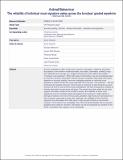Files in this item
The reliability of individual vocal signature varies across the bonobo's graded repertoire
Item metadata
| dc.contributor.author | Keenan, Sumir | |
| dc.contributor.author | Mathevon, Nicolas | |
| dc.contributor.author | Stevens, Jeroen M.G. | |
| dc.contributor.author | Nicolè, Florence | |
| dc.contributor.author | Zuberbühler, Klaus | |
| dc.contributor.author | Guéry, Jean Pascal | |
| dc.contributor.author | Levréro, Florence | |
| dc.date.accessioned | 2021-09-27T23:40:35Z | |
| dc.date.available | 2021-09-27T23:40:35Z | |
| dc.date.issued | 2020-11 | |
| dc.identifier | 270597061 | |
| dc.identifier | d39b9813-6026-483a-bf83-b414114ebd70 | |
| dc.identifier | 85091665840 | |
| dc.identifier | 000585940300002 | |
| dc.identifier.citation | Keenan , S , Mathevon , N , Stevens , J M G , Nicolè , F , Zuberbühler , K , Guéry , J P & Levréro , F 2020 , ' The reliability of individual vocal signature varies across the bonobo's graded repertoire ' , Animal Behaviour , vol. 169 , pp. 9-21 . https://doi.org/10.1016/j.anbehav.2020.08.024 | en |
| dc.identifier.issn | 0003-3472 | |
| dc.identifier.other | ORCID: /0000-0001-8378-088X/work/81797328 | |
| dc.identifier.uri | https://hdl.handle.net/10023/24034 | |
| dc.description | Funding: We thank the French Ministère de l’Enseignement Supérieur et de la Recherche (Ph.D. grant to S.K.), the Université de Saint-Etienne (research sabbaticals to F.L. and N.M., visiting professorship to K.Z. and research funding), the European Research Council (K.Z. grant PRILANG 283871), Institut universitaire de France (NM) and the Labex CeLyA. | en |
| dc.description.abstract | Vocalizations often contain both ‘dynamic’ information, related to short-term fluctuations in the individual's emotional states, and ‘static’ information, related to long-term attributes such as age, sex, weight and body size which define an ‘individual vocal signature’. While both types of information may be of functional value to receivers, dynamic information requires acoustic versatility, while static information depends on acoustic stability. Here we investigated whether an individual vocal signature is present across the vocal repertoire of the bonobo, Pan paniscus. First, the analysis of the acoustic structure of its five most common tonal vocalizations emphasized the highly graded structure of its repertoire. We then evaluated the reliability of identity information across these call types. The results show that, while all call types supported information related to identity, the reliability of these vocal signatures was not consistent along the graded vocal continuum. Caller identity was strongly encoded at one end of the acoustic gradation (high-hoot) and decreased from bark, soft bark, peep-yelp to peep calls. Strikingly, the reliability of the individual signature thus decreased from calls used in high-arousal contexts to those used in low-arousal contexts. To the best of our knowledge, this is the first demonstration that an acoustic gradation that codes for ‘dynamic’ information can be accompanied by variation in the ‘static’ information that supports vocal individuality. | |
| dc.format.extent | 13 | |
| dc.format.extent | 6932436 | |
| dc.language.iso | eng | |
| dc.relation.ispartof | Animal Behaviour | en |
| dc.subject | Acoustic grading | en |
| dc.subject | Bonobo | en |
| dc.subject | Identity information | en |
| dc.subject | Individual vocal signature | en |
| dc.subject | QL Zoology | en |
| dc.subject | Ecology, Evolution, Behavior and Systematics | en |
| dc.subject | Animal Science and Zoology | en |
| dc.subject | DAS | en |
| dc.subject.lcc | QL | en |
| dc.title | The reliability of individual vocal signature varies across the bonobo's graded repertoire | en |
| dc.type | Journal article | en |
| dc.contributor.institution | University of St Andrews. School of Psychology and Neuroscience | en |
| dc.contributor.institution | University of St Andrews. Institute of Behavioural and Neural Sciences | en |
| dc.contributor.institution | University of St Andrews. Centre for Social Learning & Cognitive Evolution | en |
| dc.identifier.doi | https://doi.org/10.1016/j.anbehav.2020.08.024 | |
| dc.description.status | Peer reviewed | en |
| dc.date.embargoedUntil | 2021-09-28 |
This item appears in the following Collection(s)
Items in the St Andrews Research Repository are protected by copyright, with all rights reserved, unless otherwise indicated.

